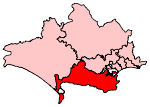Weymouth and Portland

Weymouth and Portland was a local government district and borough in Dorset, England. It consisted of the resort of Weymouth and the Isle of Portland, and includes the areas of Wyke Regis, Preston, Melcombe Regis, Upwey, Broadwey, Southill, Nottington, Westham, Radipole, Chiswell, Castletown, Fortuneswell, Weston, Southwell and Easton; the latter six being on the Isle of Portland. In Portland Harbour is the Weymouth and Portland National Sailing Academy, where the sailing events at the 2012 Olympics took place. The main reason that the resort was chosen to be an Olympic venue was that the Sailing Academy had only recently been built, so no new venue would need to be provided. Weymouth and Portland's waters have also been credited by the Royal Yachting Association as the best in Northern Europe.Weymouth and Portland have been twinned with the town of Holzwickede in North Rhine-Westphalia, Germany, since 1986, and the French town of Louviers, in the department of Eure in Normandy, since 1959.
Excerpt from the Wikipedia article Weymouth and Portland (License: CC BY-SA 3.0, Authors, Images).Weymouth and Portland
Portland Beach Road,
Geographical coordinates (GPS) Address Nearby Places Show on map
Geographical coordinates (GPS)
| Latitude | Longitude |
|---|---|
| N 50.5666 ° | E -2.4541 ° |
Address
Portland Beach Road
Portland Beach Road
DT5 1PY , Portland
England, United Kingdom
Open on Google Maps







